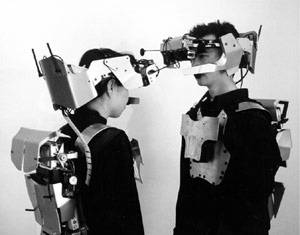A new exhibit at the Wolk Gallery (Room 7-338) shows four projects by the Center for Advanced Visual Studies ' Interrogative Design Group that use a combination of art and technology to examine, expose and respond to emerging cultural issues.
The pieces use digital images and communication devices filtered through technological suits of armor or projected onto buildings to address topics such as militarism, xenophobia and urban violence.
The Interrogative Design Group (IDG) has gained increasing international attention for its work. Members include students from MIT's Center for Advanced Visual Studies (CAVS), the Visual Arts Program, the Media Lab and the Department of Mechanical Engineering. It is led by Professor of Architecture Krzysztof Wodiczko, who is internationally recognized for his socially and politically charged public projections. Other core members are Adam Whiton, a technical assistant in CAVS, and Sung Ho Kim (S.M. 1998), an aesthetic researcher in CAVS.
One of the hallmarks of IDG's work is the application of technological equipment generally used for commercial, industrial or security purposes to help people break out of their boundaries and give them a voice.
Wodiczko conceived the piece "Dis-armor" for "school refusers"--troubled Japanese high school and middle-school students who have survived neglect, violence and abuse--to help them overcome a false sense of shame. LCD screens installed on backpacks display live images of the wearer's eyes transmitted from cameras installed in a helmet that covers the wearer's face; a loud speaker below the screen amplifies his or her voice. Attached to the helmet is a rear-view mirror, a microphone and a headphone, permitting the wearer to see the face and hear the words of the person behind them.
"Being able to confront someone while turning their back on them freed the teens to communicate instead of withdrawing," said Whiton, who noted that students' feedback and input helped with modifications and adaptations.
Another piece, "Aegis," consists of a pair of wing-like LCD screens that lie folded on the wearer's back until activated by a human voice. The screens then deploy, flanking the wearer with a mantle of differing images of the user's own face and voice in a self-dramatized and self-directed scenario. The screens broadcast pre-recorded and pre-programmed responses to repetitious or unanswerable questions such as, "What are you?" and "Where are you from?" The video images on either side of the person's face create a space between the speaker and observer. The IDG team notes that "Aegis" seeks to create "a playful distance between a stranger's drive to tell it all like it is and the spectator's overly serious and empathetic identification with the experience or trauma of the operator."
A third project, "Bandage Prototypes," consists of devices conceived for use by people in pain to express anxieties about their discomfort and to reflect the process of internal healing. The belt-like apparatus can be fastened to the stomach or across the shoulder and allows the user to pre-record statements that can be played back when he/she is questioned throughout the day. Rather than projecting the sound out towards the audience, it projects the user's voice back into her body, turning the machine into the voice, and the body into an audio chamber.
The show also features documentation of Wodiczko's "Tijuana," a "performative speech-act," performed Feb. 23-24, 2001 as the closing event of InSite 2000, a public-art festival on the Mexican-American border. The voices and faces of women who work in Tijuana factories were projected onto the round exterior of El Centro Cultural de Tijuana, a former IMAX theater, using a specially designed head-mounted camera and microphone and wearable transmission equipment. "The women were able to ... transform the building's faceless, silent mass into a manifestation of their presence," said Wodiczko, giving voice to what he called "the difficulties of their personal situations," including domestic and sexual abuse, exploitation in the workplace and police violence.
"Interrogative Design Group: Research for the Emerging Culture" is on view through Friday, April 26. The gallery is open weekdays from 9 a.m. to 5 p.m.
A version of this article appeared in MIT Tech Talk on March 20, 2002.






